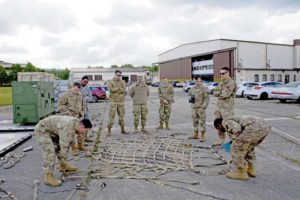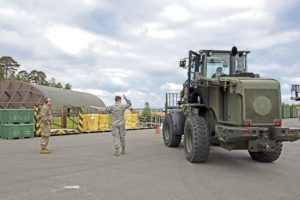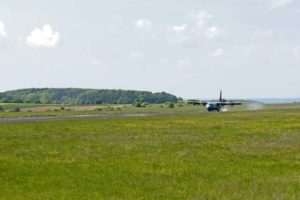Story and photos by
Aiman 1st Class Kaylea Berry
86th Airlift Wing Public Affairs

The 435th Contingency Response Group hosted a ten-day Landing Zone Safety Officer course that included in-class and field training May 20 to 31 on Ramstein Air Base. The LZSO course trains specific career fields to conduct aircraft operations and construct landing zones in challenging locations.
The course is open to air traffic controllers, airfield managers and radar weather and landing system technicians. Tasked deployers who will support a landing zone are slotted first for the course. This class consisted of 27 Airmen.
While at Bitburg Airfield, Germany, the course covered how to survey the landing zone, mark it appropriately, read the Kestrel meter, and communicate with the aircraft. Each of these actions is essential for the aircraft to land safely.
U.S. Staff Sgt. Cameron Piontek, 86th Operations Support Squadron air traffic control watch supervisor, talks about why the Air Force is moving in this direction.
“The Air Force is moving towards having a smaller carbon footprint in the areas that we are located,” said Piontek. “So that way we can go to environments where we don’t have to have an entire construction crew to build a runway. We can just go in, survey it out and make sure it’s safe for certain types of aircraft.”
Instead of having Airmen focus on their specific career field, this course trains them in multiple areas needed for a landing zone. They will be able to perform as an air traffic controller, airfield manager, and radar weather and landing system technician all in one.
“With the specialized training, we’re given certifications in equipment like the 10K forklift, all-terrain vehicles, and humvees,” said U.S. Air Force Staff Sgt. Bradley Hayward, 55th Operations Support Squadron air traffic controller. “So when we are in a deployed area we’re not stuck in our job. If an aircraft needs to be unloaded we’re certified to help.”
Hayward also spoke about why landing zones are necessary.
“It’s especially important for places that don’t have set runways. It allows us to go to locations and bring in KC-135s and heavy C-17s because they are capable of landing on materials other than concrete, such as dirt and open fields,” said Hayward.
The main focus of the course is to teach the students how to keep the ground and air crews safe and keep operations going no matter the location.
The first course at Ramstein started in June 2018 and continues to improve based on feedback from students as well as lessons learned from those downrange.




